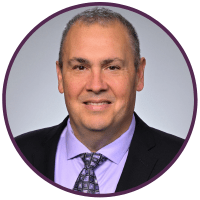Process optimization: a tool to widen cell therapy access

 Robert (Robb) Richards is the Corporate Director of The Center for Cell Therapy and Transplant at the University of Pennsylvania (PA, USA). For the past 7+ years, Robert has overseen both commercial and research arms of the program.
Robert (Robb) Richards is the Corporate Director of The Center for Cell Therapy and Transplant at the University of Pennsylvania (PA, USA). For the past 7+ years, Robert has overseen both commercial and research arms of the program.
At Advanced Therapies Week 2024 (16–19 January; Miami, Florida), Robb talked to us about how cell therapies are largely inaccessible for community hospitals and how this is being addressed by Penn Medicine’s Abramson Cancer Center, which is using data-driven process optimization to foster collaboration between community healthcare organizations and cell therapy developers.
How are you using process optimization to address challenges in the provision of cell therapies?
Penn is an anomaly in that we talk about process optimization from both the operational side as well as the manufacturing side. I came to Miami to talk about our process development for our partners: community hospitals that want to be able to treat patients closer to home with cell therapies but have never offered them.
Patients have become accustomed to being able to go to the local hospital or doctor for treatment. Right now, they can’t do that so easily with these important and complex cell therapies. We’ve been addressing this shortfall and in doing so, laying out process maps that serve as a blueprint for operationalizing high-dollar treatments.
We haven’t done that in a vacuum, we’ve been doing that right alongside the pharmaceutical companies, who historically have developed their therapies and have only offered them to specific academic sites that meet their clinical criteria.
The University of Pennsylvania has developed beyond the major academic site into two other locations, both community hospitals that have little or no experience with cell therapy before.
How is the need for increased efficiency balanced with ensuring the safety and efficacy of cell therapies?
Administering these therapies safely remains of paramount importance. The key is to provide efficiency and maintain efficacy all with optimal safety if we are to offer these treatments closer to home. The good news is that our observations have been that both academic and community alike want to be able to offer cell therapies to their patients closer to home. The bad news is that the industry, for the most part, has struggled on how to offer them closer to home. On top of that is the difficulties that we’ve seen with commercial manufacturing struggling to scale up operations just to meet a fraction of the expected demand in oncology.
I don’t think anyone will dispute the potential of these treatments in oncology. They clearly show efficacy over other treatment options now, and we’re only at the first generation of therapies. For patients who have limited options, when the treatment works, it works well and tends to be durable. While not cures for everyone, in my 20+ years in oncology I have never heard doctors say the word “cure” when referring to any other oncology treatment. They typically talk about curative or palliative treatment, not “cure.” It’s refreshing to hear from physicians that they believe we are on the path to a cure. That’s not something to take lightly and will drive physicians to want to offer these treatments beyond the small circle of centers offering it today.
I think the safety profiles of these treatments are more promising than conventional treatments and improving rapidly. Again, we’re looking at the first-generation cell therapies to be commercially available. There is already research going on to lessen the onset of toxicities in various ways: graduated dosing, steroids or tocilizumab prophylactically, etc. I believe that targeted therapies are a better solution for the future than conventional treatments.
So, that brings us to efficiency, where we see many manufacturers struggling. The interest in offering these treatments beyond academic medicine is real. I sit on a number of committees that are focused on offering these treatments in community hospitals. The problem is that many pharma companies have struggled to scale up their operations in terms of yield to commercial-grade therapy. That has significant problems for both academic and community alike as, depending on the availability of product or degree of out-of-spec product, which will relegate the treatment as a research-grade treatment. This in turn impacts the physician’s appetite for ordering the product, which in turn impacts access as the physician is less likely to order the product in the long run.
So, in short, we see safety and efficacy as positives and efficiency as a negative (for now). We acknowledge that everyone is learning in this space and that there hasn’t been a framework to work from with cell therapies back in 2017. We see that companies are learning from the challenges of growing a new industry and are asking questions of institutions earlier in trials in preparation for commercialization. I see that companies are working with other companies to manufacture product (CDMO). I’m optimistic that we will get the issue of efficiency right in the future.
Could you expand on how these methods are fostering partnerships between community hospitals and cell therapy developers?
I’ve had the good fortune of being with the physicians who were the pioneers of cell therapy, for example, Carl June, Bruce Levine, David Porter and Steve Grupp (all University of Pennsylvania; PA, USA). They know cellular therapies inside out. As someone who has over 20 years experience in oncology, I came to Penn in late 2016 and found myself having very little understanding of cellular therapies. Those physicians took the time to teach me about their world, which I am eternally grateful for them doing. I spent my first year just learning about the space while trying to figure out how to operationalize the impending commercial CAR-T therapies. The idea of an educational framework was born from my own personal experience during this time; that as the number of therapies grew and their clinical impact would have them moving up in earlier lines of use, we would see that others would want to use them as therapy though they would have little or no experience using them. The challenge here is that Penn can’t do it alone, that we need to collaborate with industry to show that we can offer these treatments closer to home and do it with the same safety and quality standards developed at the academic sites.
Penn is trying to lead the way but do it in a highly visible and transparent way. The first step was to develop process maps for the overall episode of care in cell therapy. We started with each one of the community sites to collaborate with the pharmaceutical company and provide a visual tool that they could see, understand, and get some perspective on the pain points of the community sites and how they will differ from established academic centers.
What I didn’t appreciate until the end was that we were putting a blueprint together that you can use and adapt for others to follow centers that would otherwise be hesitant to offer these treatments because of the high cost and the risk associated with it.
Right now, the number of patients with Diffuse large B cell lymphoma and myeloma say that we should be treating a lot more patients than we are. The reason for that, I believe, is, one, because access is limited and, two, not all patients either can or want to make the journey to a treatment center that they’re not familiar with and may be a long distance away. I believe that if we give the tools necessary to improve access it will have benefit for all stakeholders in the CGT space. So, that’s my mission in the years to come.
In the age of data-driven decision-making, how is your program addressing challenges related to integrating data and analytics into the optimization process?
For perspective, my program, commercially, will infuse about 140–150 patients in a 12-month period, and then an additional 100 patients in research. That’s just cell therapies at our academic center. Our first community site has treated five patients already and our second site is just getting started.
Data is absolutely central in all of this. Thinking about it from the perspective of the pharmaceutical company, they should have assurances that provider sites, that may have little experience with cell therapy, can provide optimal quality and safety.
So, we developed investigator-initiated trials, where we’re working collaboratively with pharmaceutical companies to collect data to show that delivering this care in the community is just as safe as doing it in the academic centers. You have to recognize and appreciate that your partner pharmaceutical company is taking the leap of faith and you have to show them that you’re being thoughtful about that process.
What trends do you anticipate in the field of process optimization for cell therapies, and how should developers prepare for the future?
From my perspective, I think manufacturing generally does a good job when you think about what it takes to make that product. While there is still area for improvement in reduced manufacturing times and high yield to spec, it doesn’t surprise me where we are at now. I see similarities to the PC industry; that in the early days computers were hand built (slower to make and less reliable) and evolved to computerized manufacturing (faster to make and more reliable). I think that part of the journey of cell therapy is well underway and I have no doubt that we will get to a place where manufacturing times will substantially decrease and successful yield will improve. I think the area where we need to improve is when the ‘baton’ is passed back to the institution. Improved manufacturing times and yield are great, but given the pipeline of therapies in the space, access has the potential to stifle the overall growth of the space. We need to start thinking about access now if we want to keep the space growing and evolving.
The opinions expressed in this interview are those of the author and do not necessarily reflect the views of RegMedNet or Taylor & Francis Group.